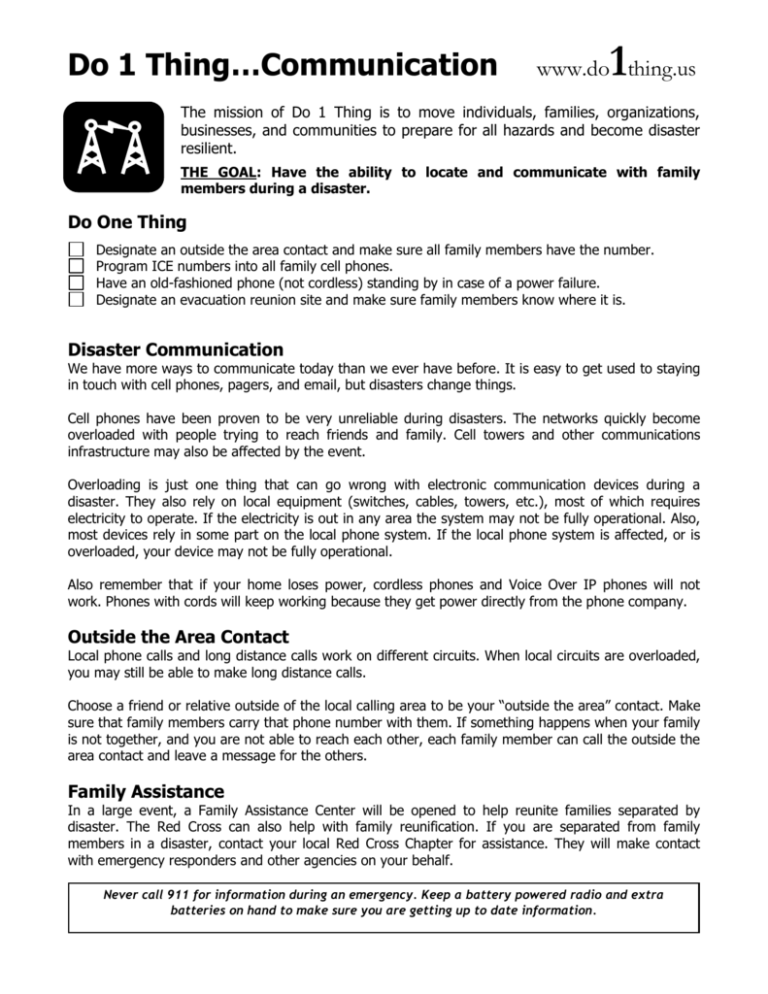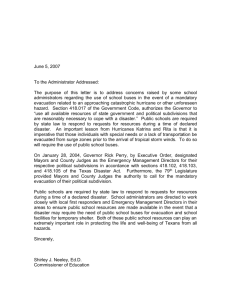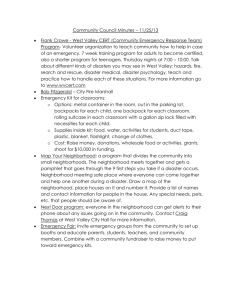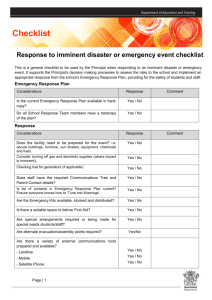July
advertisement

Do 1 Thing…Communication 1 www.do thing.us The mission of Do 1 Thing is to move individuals, families, organizations, businesses, and communities to prepare for all hazards and become disaster resilient. THE GOAL: Have the ability to locate and communicate with family members during a disaster. Do One Thing Designate an outside the area contact and make sure all family members have the number. Program ICE numbers into all family cell phones. Have an old-fashioned phone (not cordless) standing by in case of a power failure. Designate an evacuation reunion site and make sure family members know where it is. Disaster Communication We have more ways to communicate today than we ever have before. It is easy to get used to staying in touch with cell phones, pagers, and email, but disasters change things. Cell phones have been proven to be very unreliable during disasters. The networks quickly become overloaded with people trying to reach friends and family. Cell towers and other communications infrastructure may also be affected by the event. Overloading is just one thing that can go wrong with electronic communication devices during a disaster. They also rely on local equipment (switches, cables, towers, etc.), most of which requires electricity to operate. If the electricity is out in any area the system may not be fully operational. Also, most devices rely in some part on the local phone system. If the local phone system is affected, or is overloaded, your device may not be fully operational. Also remember that if your home loses power, cordless phones and Voice Over IP phones will not work. Phones with cords will keep working because they get power directly from the phone company. Outside the Area Contact Local phone calls and long distance calls work on different circuits. When local circuits are overloaded, you may still be able to make long distance calls. Choose a friend or relative outside of the local calling area to be your “outside the area” contact. Make sure that family members carry that phone number with them. If something happens when your family is not together, and you are not able to reach each other, each family member can call the outside the area contact and leave a message for the others. Family Assistance In a large event, a Family Assistance Center will be opened to help reunite families separated by disaster. The Red Cross can also help with family reunification. If you are separated from family members in a disaster, contact your local Red Cross Chapter for assistance. They will make contact with emergency responders and other agencies on your behalf. Never call 911 for information during an emergency. Keep a battery powered radio and extra batteries on hand to make sure you are getting up to date information. In Case of Emergency (ICE) If you are injured and not able to give information, police and hospital personnel may not be able to contact your family right away. If you have a cell phone you can provide that information to emergency personnel: 1. Create a new contact in your cell phone’s phone book 2. Name the contact ICE 3. Enter the phone numbers for the person you would like to have notified if you have a medical emergency Evacuation Plan If your neighborhood is evacuated while you are not at home, you will not be allowed to return to your house. Designate a reunion site outside of your neighborhood where all family members can meet. Do this ahead of time, so that you don’t have to rely on phones or other electronic means to communicate after something happens. Your reunion site should be someplace that is not in your immediate neighborhood, but is well-known by the family, like a park, restaurant, or shopping center. Try not to use schools as a meeting point. School buildings may be designated as emergency shelters or medical facilities during a disaster, and you may not be allowed to wait there for others. Make sure your location is accessible at all hours. Make sure everyone in your family knows where the reunion site is and that they should go there if they hear on the radio that your neighborhood is affected, or if they are told when they try to go home that they can’t enter the area. Pets: Consider asking someone else in your neighborhood to evacuate your pet if an evacuation order is issued when you are not at home. Make sure your pet has identification at all times, in case you are separated during a disaster. Microchipping is a safe, inexpensive way to increase your chances of being reunited with your pets. Don’t confuse the evacuation reunion site with the evacuation location outside your home that you would go to after a fire. That location should be nearby, and family members should meet there after getting out of the house, so that you can be sure everyone is safe. Looking Out for Each Other If you know someone who could have trouble getting emergency information for any reason, or might have trouble following emergency instructions (especially evacuation or sheltering in place), offer to contact them or check on them during a disaster. Make sure that there is someone else who can follow up with them if you are not able. Talking About Disaster The hardest part of preparing your family for a disaster may be talking to your children about it. Kids need two things when talking about disaster: understandable information and realistic reassurance. Treat talking about disaster with your children the same way you would treat any other difficult subject. As they get older and more independent they will need, and be able to understand, more information. Knowing what to do in a disaster can help many children (and adults) cope with anxiety about the unknown. For more information http://www.iceyourphone.org/ http://www.ready.gov/kids/parents/communicate.html http://www.avma.org/disaster/saving_family.asp http://www.do1thing.us









